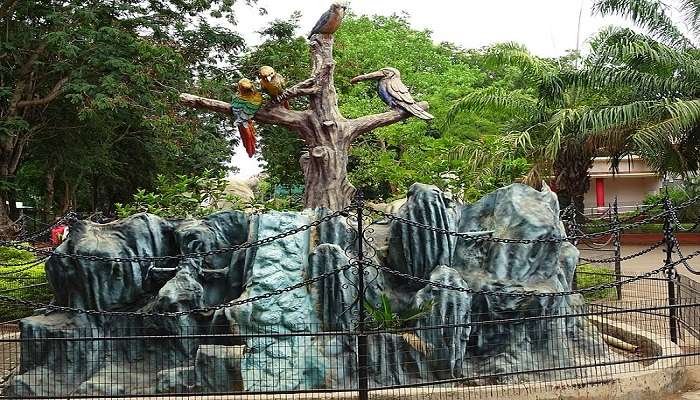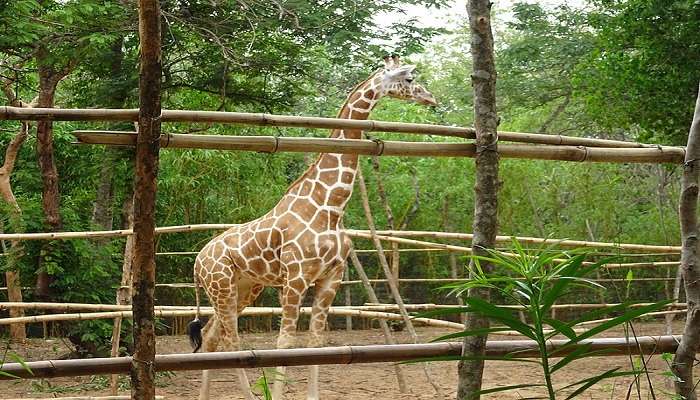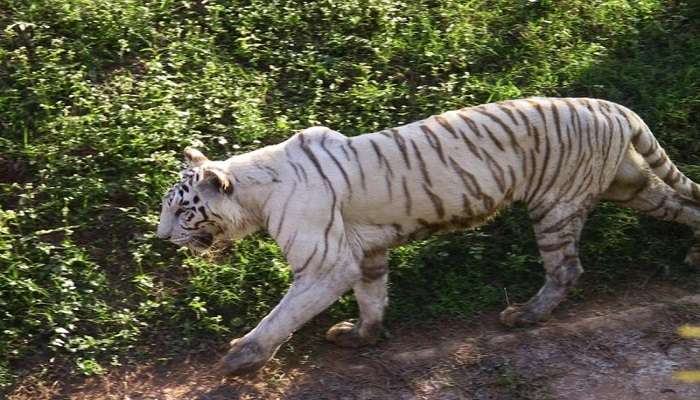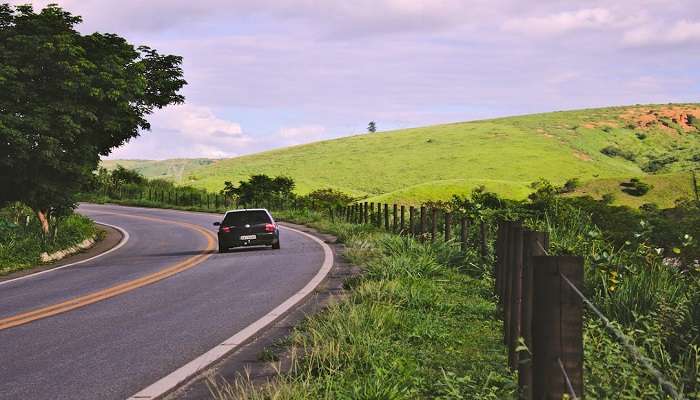Visit Nandankanan Zoological Park Bhubaneswar In Odisha In 2025

Nandankanan Zoological Park Bhubaneswar In Odisha is a 437-hectare zoo and botanical garden. Established in 1960, it was opened to the public in 1979 and became the first zoo in India to join the World Association of Zoos and Aquariums (WAZA) in 2009. It also contains a botanical garden, and part of it has been declared a sanctuary. Nandankanan, literally meaning The Garden of Heaven, is located near the capital city, Bhubaneswar, in the environs of the Chandaka forest and includes the 134-acre Kanjia lake. A major upgrade was done in 2000 (after the damage caused by the super-cyclone of 1999 in coastal Odisha). More than 2.6 million visitors visit Nandankanan every year.
About Nankankadan Zoological Park Bhubaneswar In Odisha

Located 15 KM from Bhubaneswar, Nandankanan means “celestial garden”, came into existence on the 29th of December, 1960. However strange it may seem, the zoo came up as an afterthought. During the World Agriculture Fair held in New Delhi in 1960, the Odisha pavilion displayed animals from Odisha in its stall. Once the fair was over, the realization dawned that the animals needed a home. After many deliberations, the current site in Junagadh Forest block was selected. Unlike other zoos, Nandankanan is built inside the forest and is set amidst the natural environment. The animals are housed in spacious enclosures that replicate their habitat, enabling them to settle down and lead a healthy life. Nandankanan is one of the most prominent zoological parks in the world and has many firsts to its credit.
It is most famous for its white tigers and is the host zoo for the species. Some of the other firsts are that It is the first zoo to breed the endangered Gharials in captivity. School children are invited to participate in competitions like sit and draw and other activities like naming tiger cubs during Wildlife Week, Elephant Day and Wetland Day.
Must Read: Places To Visit In Bhubaneswar
History Of The Zoological Park

The history of Nandankanan Zoological Park begins with the 1960 Delhi fair, where Odisha’s forest department captured various small animals for display. After the fair, these animals were brought back to Bhubaneswar in May 1960, creating housing and feeding challenges for the forest department. The State Finance Department initially opposed establishing a zoo due to cost concerns. However, temporary structures were built at Khandagiri to house the animals, with the local Jain community assisting in feeding them. The idea of a permanent zoo gained traction after a visit from Dr. H. K. Mahatab, then Chief Minister of Odisha. Although Ghatikia was first proposed as the zoo’s location, water scarcity concerns led to selecting the Jujhagarh forest block near Kanjia Lake.
This site offered scenic beauty and ample water but was 38 km from Bhubaneswar via Chandaka. A committee, impressed by the location’s aesthetic appeal, recommended building a 14-15 km direct road from Bhubaneswar. The plan included establishing the Zoological Park in Jujhagarh Forest Block, a botanical garden in Krushnanagar Forest Block, and developing Kanjia Lake for recreation. The 134-acre site around Kanjia Lake was chosen, and Nandankanan Biological Park was officially inaugurated on December 29, 1960, by Sri S. K. Patil, then Indian Minister of Food and Agriculture. In 1963, a botanical garden opened. The zoo received its first tiger in 1964 from Alipore Zoo in Calcutta, along with African lions, Mugger crocodiles, and a puma. In 1981, the facility was renamed Nandankanan Zoological Park. A significant milestone was reached in 2009 when Nandankanan Zoological Park became the first zoo in India to join the World Association of Zoos and Aquariums (WAZA), marking its importance in the global zoo community.
Botanical Garden In Nandankanan Zoological Park

The adjoining Botanical Park was opened to the public in 1963. In 1981-1982, it was renamed Nandankanan Zoological and Botanical Park under the recommendation of the Odisha Legislative Committee on Estimates. The botanical garden, set beside the Kanjia Lake, houses many rare species of plants and trees and perfectly complements the zoological park on the other side of the lake.
Suggested Read: Resorts In Bhubaneswar
Nankankadan Zoological Park Ticketing And Pricing

- Entry Fee: for adults (over 12 years) is 50, while children (3-12 years) pay 10. Foreign nationals are charged 100.
- Photography Fees: The handy cam costs 100, the high-end video camera 500, and the movie camera 4000.
- Safaris: 45 minutes for 4 safaris are available in non-AC and AC options. Non-AC safaris, including Lion, White Tiger, Bear, and Herbivore, cost 65. AC safaris for the same routes are priced at 100.
- Boating: Options for 30 minutes include 2-seater paddle boats at 50, 4-seater at 100, and 6-seater family boats at 150.
- The Toy Train: The ride costs 50 for adults and 30 for children over 3 years.
- Ropeway: Access is 120 per person for those above 3 years.
- Multi-Level Car Parking Fees: are bicycles 5 for 6 hours, motorcycles and two-wheelers 20 for 6 hours (including helmet charges if desired), three-wheelers 30 for 6 hours, four-wheelers (LMV) 50 for 6 hours, and buses 70 for 6 hours.
- A Cloak Room is available for storing single packets or luggage.
These diverse activities and amenities cater to various interests and age groups, offering a range of experiences from wildlife safaris to recreational boating and convenient parking options.
How To Reach

There are a lot of ways to reach this beautiful Zoological Park:
By Air:
Bhubaneshwar Airport, or Biju Patnaik International Airport, located around 6 km from the city centre, connects this historical city with the rest of the country via a network of flights. From the airport, travellers can avail of taxi/bus services to reach Bhubaneshwar.
By Road:
The city of Bhubaneswar enjoys good connectivity with other parts of the country by national highways and roads. The main bus station at Baramunda is around 5 km away from the city centre and regular bus services are available for cities like Konark, Puri, Sambalpur, Cuttack, Paradip and Rourkela.
By Train:
Bhubaneswar Railway Station, situated at around 5 km, is the main railhead connecting the city with several Indian cities. Frequent superfast trains are available from Mumbai, Kolkata, Delhi, Chennai, Hyderabad, Bangalore, and several other major destinations in India.
Further Read: Nightlife In Bhubaneswar
Now that you have a list of things to remember for your next vacation to see the beautiful Nandankanan Zoological Park Bhubaneswar in Odisha make sure you plan your trip to Odisha to these fabulous spots for the experience of a lifetime. Don’t miss out on these opportunities; book your tickets now!
For our editorial codes of conduct and copyright disclaimer, please click here.
Cover Image credit: By Jitendraamishra for Wikimedia Commons.
Frequently Asked Questions About Nandankanan Zoological Park Bhubaneswar In Odisha
What are the main attractions at Nandankanan Zoological Park?
The park is famous for its white tigers, lions, and diverse bird species. It also features a botanical garden, a reptile park, and the picturesque Kanjia Lake.
What are the visiting hours and entry fees of Nandankanan Zoological Park?
The zoo is open from 7:30 AM to 5:30 PM, except Mondays. Entry fees are typically around INR 50 for adults and INR 25 for children, but confirm current rates before visiting.
Are there any special activities available at Nandankanan Zoological Park?
Yes, the park offers activities like boating on Kanjia Lake, a toy train ride, and a ropeway for aerial views. There's also a nocturnal animal house for night-time wildlife observation.
How accessible is Nandankanan from Bhubaneswar?
The zoo is located about 15 km from Bhubaneswar city center. It's easily reachable by taxi, auto-rickshaw, or public bus.
What's the best time to visit Nandankanan Zoological Park?
The best time to visit is from October to March when the weather is pleasant. Early mornings are ideal for animal watching as they're more active then.
People Also Read:
Jim Corbett National Park Kui Buri National Park Ream National Park

As a Travel Content Writer, I live to conquer the world of globetrotting with words. With my unquenchable thirst for storytelling, I believe that my words will inspire you to travel around the world’s breathtaking landscapes. As for me, I am an unapologetic selenophile, who loves to wander around in a starry night!











